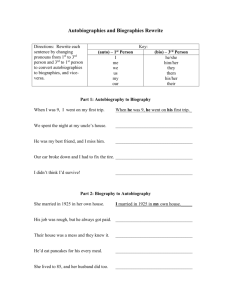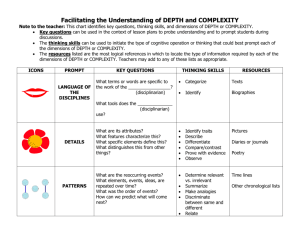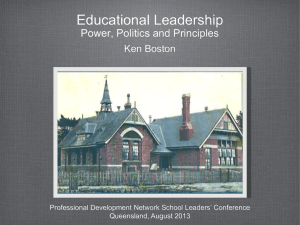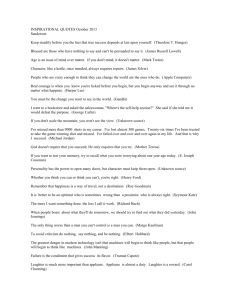Depth and Complexity Icons and Questions
advertisement
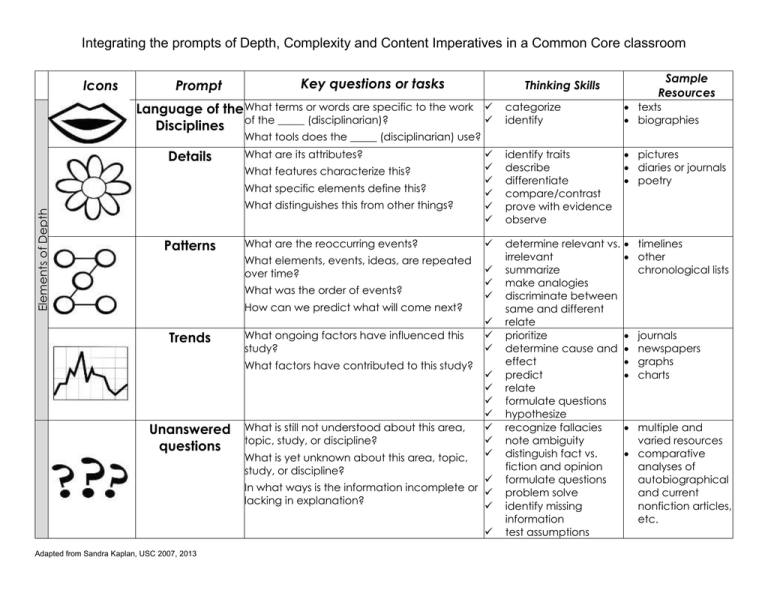
Integrating the prompts of Depth, Complexity and Content Imperatives in a Common Core classroom Icons Prompt Key questions or tasks Sample Resources Thinking Skills Language of the What terms or words are specific to the work Disciplines of the _____ (disciplinarian)? categorize identify texts biographies What are its attributes? identify traits describe differentiate compare/contrast prove with evidence observe pictures diaries or journals poetry determine relevant vs. irrelevant summarize make analogies discriminate between same and different relate prioritize determine cause and effect predict relate formulate questions hypothesize recognize fallacies note ambiguity distinguish fact vs. fiction and opinion formulate questions problem solve identify missing information test assumptions timelines other chronological lists What tools does the _____ (disciplinarian) use? Details What features characterize this? Elements of Depth What specific elements define this? What distinguishes this from other things? Patterns What are the reoccurring events? What elements, events, ideas, are repeated over time? What was the order of events? How can we predict what will come next? Trends What ongoing factors have influenced this study? What factors have contributed to this study? Unanswered questions What is still not understood about this area, topic, study, or discipline? What is yet unknown about this area, topic, study, or discipline? In what ways is the information incomplete or lacking in explanation? Adapted from Sandra Kaplan, USC 2007, 2013 journals newspapers graphs charts multiple and varied resources comparative analyses of autobiographical and current nonfiction articles, etc. Integrating the prompts of Depth, Complexity and Content Imperatives in a Common Core classroom Icons Prompt Rules Key questions or tasks How is this structured? What are the stated and unstated causes related to the description or explanation of what we are studying? Impact How does _____ influence _____? What are the effects of _____ on _____? Process What steps are used to create this? Why type of procedure is involved? Motive What is causing this to happen? How is the idea or work stimulated? Proof What information verifies this? How can this be validated? Ethics Adapted from Sandra Kaplan, USC 2007, 2013 generalize hypothesize judge credibility affect identify force quotes editorials persuasive essays sequence connect link order arrange reason excite inquire explain determine fact vs. statistics opinion maps support with evidence encyclopedia authenticate prove document What dilemmas or controversies are involved in this area, topic, study, or discipline? What elements can be identified that reflect bias, prejudice, and discrimination? Sample Resources Thinking Skills judge with criteria determine bias editorials essay laws theories continuum storyboard flow chart timeline biographies autobiographies interviews editorials essays autobiographies journals Integrating the prompts of Depth, Complexity and Content Imperatives in a Common Core classroom Icons Prompt Key questions or tasks What overarching statement best describes Big ideas (generalizations what is being studied? general statement includes what is , principles, and What being studied? theories) Over time How are ideas related between the past, present, and future? How are those ideas related within or during a prove with evidence quotations generalize discipline-related identify the main idea essays relate sequence order particular time period? How has time affected the information? Elements of Complexity How and why do things change or remain the same? Different points of view What are the opposing viewpoints? How do different people and characters see this event or situation? Interdisciplinary How is “across disciplines” related to “multiple Relationships perspectives? How do experts in a discipline learn from experts in other disciplines? How would you describe a topic’s place in more than one discipline or subject area? Context What determines the outcome of an event? What features, conditions, or circumstances describe the situation? How does the environment shape or affect what is happening? Adapted from Sandra Kaplan, USC 2007, 2013 Sample Resources Thinking Skills argue determine bias classify time lines text biographies autobiographies historical documents biographies autobiographies mythologies and legends vs. nonfiction accounts debates describe biographies prioritize importance autobiographies identify relationships economics judge with criteria data collection compare and contrast and analysis communicating research finding human behavior define pictures describe descriptive essay illustrate narratives influence virtual field trips almanacs video tapes Integrating the prompts of Depth, Complexity and Content Imperatives in a Common Core classroom Icons Prompt Translate Original Judgment Key questions or tasks What are the multiple and varied meanings of the language? How is the same idea interpreted in different situations and by different people? Why is it new? What makes it new? How does time and place make it new? restate interpret recite express explain convert transfer create design innovate modify redesign thesaurus dictionary of professional terms dictionary What factors will influence what is happening? decide determine agree disagree verify investigate identify options to argue laws newspapers philosophy books How is the decision to be made? Adapted from Sandra Kaplan, USC 2007, 2013 Sample Resources Thinking Skills copyright laws encyclopedia artifacts museums Integrating the prompts of Depth, Complexity and Content Imperatives in a Common Core classroom What evidence can we cite to show that identify attributes texts Parallel some ideas or events are parallel? compare and contrast judge with criteria support and prove with evidence Judge the authenticity of the paradoxes related to _____. Differentiate fact from fiction to determine paradoxes in ______. differentiate fact from fiction determine relevant from irrelevant judge with criteria judge authenticity Identify attributes of parallels among two or more subject areas Compare and contrast parallel patterns in______. Content Imperatives Paradox Develop criteria for deciding what makes a paradox in _____. Origin Prove with evidence the source or origin of____. Trace the beginnings of _____. Identify the origins of ______. note ambiguity identify missing information test assumptions prove with evidence Contribution Use the language of the discipline to describe the contributions, over time of two ______. Prioritize the relative value of __________. Judge with criteria the impact of ___________ on the overall source. differentiate relevant from irrelevant judge with criteria prioritize prove with evidence Convergence Provide with evidence that a convergence of ideas led to the ____________. What relationships exist between _____ and sequence recognize relationships state and test assumptions identify cause and effect _____ that led to the field of ______? State and test assumptions about the ____ and _____ which converge in the _____ Adapted from Sandra Kaplan, USC 2007, 2013 problem solving similar events in history cultures controls, variables laws, principles, theories poetry, science fiction number puzzles political cartoons group behaviors missing or gaps in evidence hypotheses novels fairy tales statistics number system political structures inventions authors, historians, etc. technology civilizations cultures experimentation techniques word roots problem solving equations historical events emerging knowledge consilience
